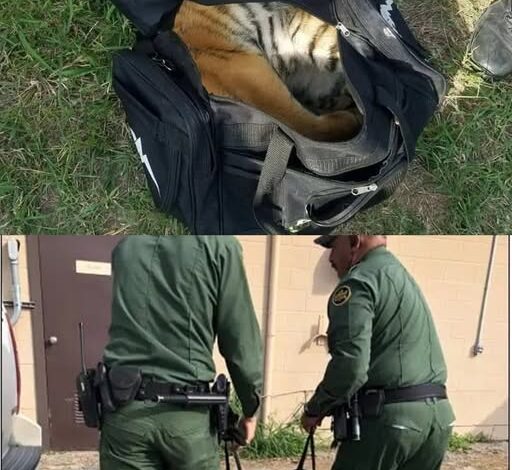Border Rescue Unveils a Tiger in a Bag, Stunning Everyone

As the sun set over Brownsville, Texas, the Rio Grande’s banks were bathed in warm hues of orange and pink, but the beauty of dusk masked a tense reality. For Border Patrol agents in this region, evening is a time of heightened vigilance. The fading light can conceal migrants seeking safety, smugglers transporting contraband, and traffickers exploiting both human and animal lives. Every shadow has the potential to hide danger or desperation.
On one particular evening, agents spotted three men moving cautiously along the muddy riverbank. One carried a large black duffel bag, oddly lumpy, as if concealing something alive. As the agents approached, the men abruptly abandoned the bag and vanished into the brush, their hurried steps muffled by the undergrowth.
Cautiously, the agents unzipped the bag and were met with a shocking sight: a tiny tiger cub, no older than three or four months, trembling and weak, struggling to breathe. Its fur was dirty and damp, and its chest rose and fell in shallow, uneven breaths. The men were gone, leaving no explanation for why the cub had been abandoned on the riverbank.
This was not a typical seizure of drugs or weapons. It was a living, breathing life — an endangered animal victim of the illegal wildlife trade. Recognizing the urgency, the agents immediately contacted wildlife rescue experts and transported the cub to the Gladys Porter Zoo.
At the zoo, a team of veterinarians and animal care specialists worked tirelessly to stabilize the cub, soon named “Zuko.” They administered fluids to combat dehydration, provided warmth, and closely monitored his vital signs. The cub’s survival was uncertain; his first hours at the zoo were critical. Gradually, Zuko began responding, opening his eyes and showing improved strength.
While Zuko’s rescue offered hope, it also highlighted a grim global reality. Fewer than 3,200 tigers remain in the wild, their populations devastated by poaching, habitat loss, and trafficking. Paradoxically, the U.S. is home to roughly 5,000 tigers in captivity — more than exist in their natural habitats across Asia.
Many of these tigers are kept outside of accredited zoos, in roadside menageries, private collections, or unregulated breeding facilities, where oversight is minimal. The illegal exotic pet trade thrives on demand for rare and dangerous animals, driven by greed, status, and ignorance. Tigers stolen or bred illegally often suffer in cruel conditions — malnourished, neglected, and deprived of proper care.
Traffickers operate via complex, covert networks, smuggling cubs across borders in bags, crates, and cages. The trade often intersects with human trafficking, drug smuggling, and organized crime, complicating enforcement efforts.
Zuko’s rescue became more than saving one cub — it symbolized the fight against wildlife trafficking, underscoring the need for stronger laws, international cooperation, and public awareness. Each rescued animal is a life saved and a victory against the shadowy networks that threaten endangered species.
Conservation organizations, including the Gladys Porter Zoo, continue advocating for stricter regulations on exotic pet ownership, improved border enforcement, and education on the consequences of illegal wildlife trade. Beyond law and policy, Zuko’s story highlights the human capacity for compassion — the team who cared for him invested time, expertise, and hope to give him a second chance.